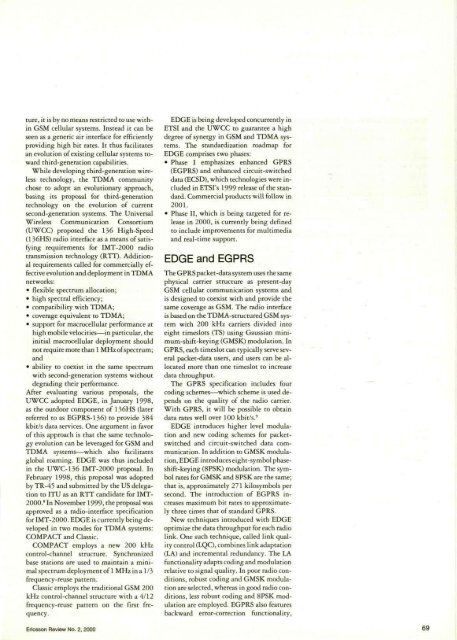ericssonhistory.com
ericssonhistory.com
ericssonhistory.com
- No tags were found...
You also want an ePaper? Increase the reach of your titles
YUMPU automatically turns print PDFs into web optimized ePapers that Google loves.
ture, it is by no means restricted to use withinGSM cellular systems. Instead it can beseen as a generic air interface for efficientlyproviding high bit rates. It thus facilitatesan evolution of existing cellular systems towardthird-generation capabilities.While developing third-generation wirelesstechnology, the TDMA <strong>com</strong>munitychose to adopt an evolutionary approach,basing its proposal for third-generationtechnology on the evolution of currentsecond-generation systems. The UniversalWireless Communication Consortium(UWCC) proposed the 136 High-Speed(136HS) radio interface as a means of satisfyingrequirements for IMT-2000 radiotransmission technology (RTT). Additionalrequirements called for <strong>com</strong>mercially effectiveevolution and deployment in TDMAnetworks:• flexible spectrum allocation;• high spectral efficiency;• <strong>com</strong>patibility with TDMA;• coverage equivalent to TDMA;• support for macrocellular performance athigh mobile velocities—in particular, theinitial macrocellular deployment shouldnot require more than 1 MHz of spectrum;and• ability to coexist in the same spectrumwith second-generation systems withoutdegrading their performance.After evaluating various proposals, theUWCC adopted EDGE, in January 1998,as the outdoor <strong>com</strong>ponent of 136HS (laterreferred to as EGPRS-136) to provide 384kbit/s data services. One argument in favorof this approach is that the same technologyevolution can be leveraged for GSM andTDMA systems—which also facilitatesglobal roaming. EDGE was thus includedin the UWC-136 IMT-2000 proposal. InFebruary 1998, this proposal was adoptedby TR-45 and submitted by the US delegationto ITU as an RTT candidate for IMT-2000. 8 In November 1999, the proposal wasapproved as a radio-interface specificationfor IMT-2000. EDGE is currently being developedin two modes for TDMA systems:COMPACT and Classic.COMPACT employs a new 200 kHzcontrol-channel structure. Synchronizedbase stations are used to maintain a minimalspectrum deployment of 1 MHz in a 1 /3frequency-reuse pattern.Classic employs the traditional GSM 200kHz control-channel structure with a 4/12frequency-reuse pattern on the first frequency.EDGE is being developed concurrently inETSI and the UWCC to guarantee a highdegree of synergy in GSM and TDMA systems.The standardization roadmap forEDGE <strong>com</strong>prises two phases:• Phase I emphasizes enhanced GPRS(EGPRS) and enhanced circuit-switcheddata (ECSD), which technologies were includedin ETSI's 1999 release of the standard.Commercial products will follow in2001.• Phase II, which is being targeted for releasein 2000, is currently being definedto include improvements for multimediaand real-time support.EDGE and EGPRSThe GPRS packet-data system uses the samephysical carrier structure as present-dayGSM cellular <strong>com</strong>munication systems andis designed to coexist with and provide thesame coverage as GSM. The radio interfaceis based on the TDMA-structured GSM systemwith 200 kHz carriers divided intoeight timeslots (TS) using Gaussian minimum-shift-keying(GMSK) modulation. InGPRS, each timeslot can typically serve severalpacket-data users, and users can be allocatedmore than one timeslot to increasedata throughput.The GPRS specification includes fourcoding schemes—which scheme is used dependson the quality of the radio carrier.With GPRS, it will be possible to obtaindata rates well over 100 kbit/s.'EDGE introduces higher level modulationand new coding schemes for packetswitchedand circuit-switched data <strong>com</strong>munication.In addition to GMSK modulation,EDGE introduces eight-symbol phaseshift-keying(8PSK) modulation. The symbolrates for GMSK and 8PSK are the same;that is, approximately 271 kilosymbols persecond. The introduction of EGPRS increasesmaximum bit rates to approximatelythree times that of standard GPRS.New techniques introduced with EDGEoptimize the data throughput for each radiolink. One such technique, called link qualitycontrol (LQC), <strong>com</strong>bines link adaptation(LA) and incremental redundancy. The LAfunctionality adapts coding and modulationrelative to signal quality. In poor radio conditions,robust coding and GMSK modulationare selected, whereas in good radio conditions,less robust coding and 8PSK modulationare employed. EGPRS also featuresbackward error-correction functionality,Ericsson Review No. 2, 2000















